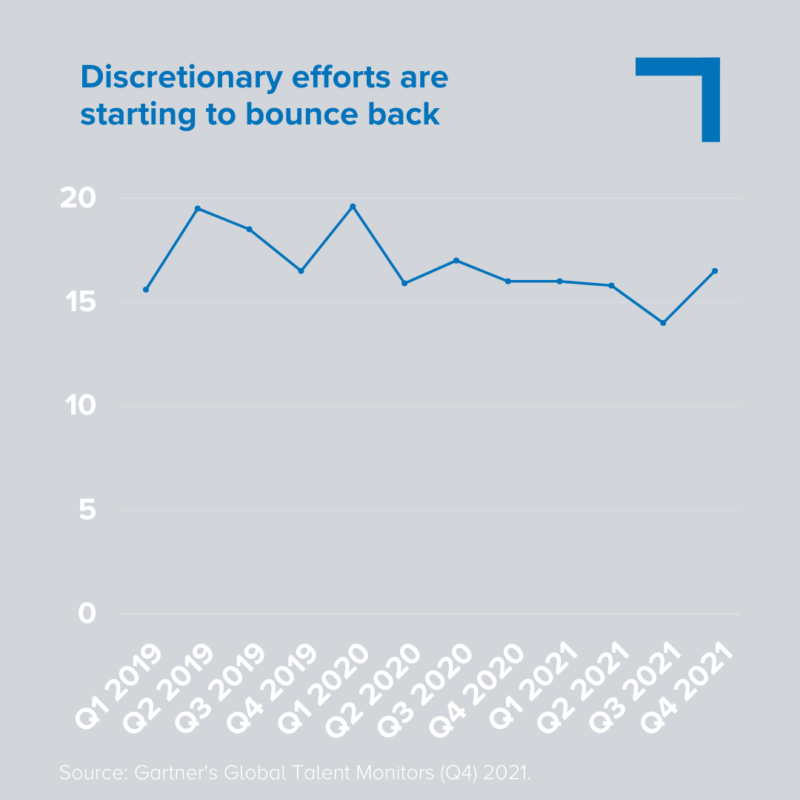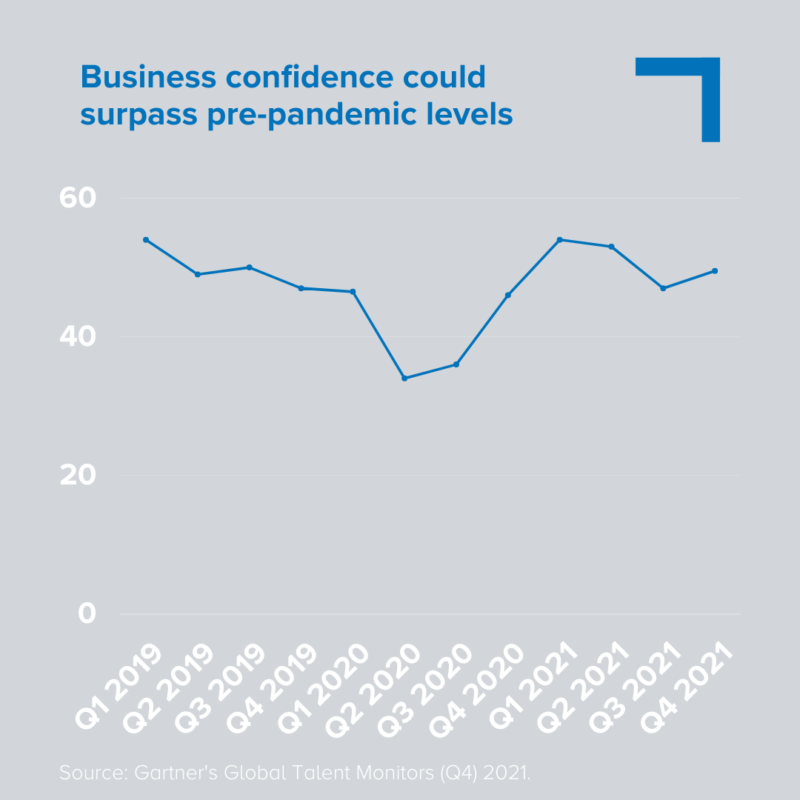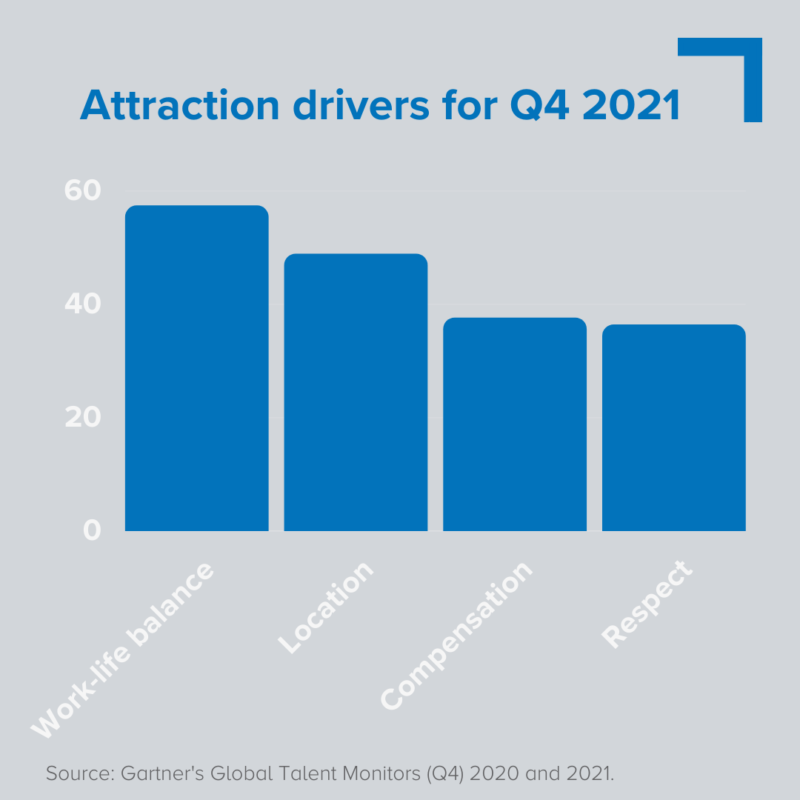New data shows a promising uptick in discretionary effort and business confidence. While this might send some employees in search of greener pastures, this expert says you could very well see them return to you.
There’s plenty to consider when planning the upcoming year at work. How will you cope with skills shortages? What can you do to quell high resignation rates? How can you ensure you’re delivering on employees’ expectations? What should your workforce planning strategy zero in on?
Gartner’s latest quarterly talent monitor data, which crunches data from across 40 countries representing thousands of employees and will be publicly released next week, offers some interesting insights that could help to inform some of your key workforce planning strategies for the start of 2022.
Want to skip to the part that interests you most? Here’s what we’re covering in this article:
-
- Discretionary effort is back on track – but employers need to do more to maintain it.
- Business confidence is bouncing back – while this is great news for business, it also encourages employees to go searching for greener pastures.
- You should factor boomerang employees into your talent planning – some employees might be quick to jump ship, but it won’t always work out. There are some small things employers can do to entice them back.
- Managers are driving attrition rates – investment in leadership training should be front of mind.
1. Employees are putting in more effort
Discretionary efforts have been bouncing all over the place over the last two years.
In 2020, during the peaks of the pandemic, we saw discretionary efforts rise to above pre-pandemic levels which initially surprised some, considering the majority of workers were operating under extreme pressure and stress.
However, experts predicted this spike was related to stress around job loss – employees went above and beyond to prove to their employer they were worth keeping or, in some cases, to keep food on the table.
“I also think a lot of it was driven by people wanting to help each other out as well,” says Robin Boomer, Director of Research and Advisory at Gartner.

“[That 2020 increase in discretionary effort] was driven by the narrative that we’re all in a pandemic, let’s pull in the same direction to make it easier on everybody. There was also this recognition that some of your colleagues might be doing it tougher than you or that you’re lucky to still even have a job.”
However, as demonstrated in the graph above, discretionary effort plummeted in the second quarter of 2020 when exhaustion and burnout kicked in, and the impacts of mass job losses impacted those who remained employed.
“People were trying to keep up with the level of intensity [exhibited in 2020]. They were also trying to overlay the same kind of working styles to a hybrid or virtual context that they’d use in a physical work environment and that wasn’t working.
“And there’s also that expectation or desire that a lot of managers had to recreate the team environment virtually, which meant increased numbers of team meetings and virtual interactions. So that was actually very fatiguing for people,” says Boomer.
Other than a brief spike in the third quarter of 2020, discretionary efforts continued to trend downwards, hitting its lowest point in two years in between July and September last year.
But a new year has brought a renewed sense of wanting to go above and beyond at work. Is this just a side effect of a much-needed break, or is there something else going on?
“People are going to be willing to invest that extra effort, but they’ll want something in return for it.” – Robin Boomer, Director of Research and Advisory, Gartner
Boomer says the end of the 2021 quarter marked the beginning of the ‘radical reset’, meaning employees and candidates have set clearer boundaries about what they will and won’t accept.
Where they might have once worked themselves into the ground to meet the demands of an increased workload, some are now more comfortable switching off at a reasonable hour to tend to other important aspects of their lives – like time with family or working on personal passion projects. All of this could be driving an increase in discretionary effort.
But here’s the catch for employers. Active job searching behaviours tend to peak during the early stages of the year, pandemic or no pandemic. Pair this with the recent spike in business confidence (see section below) and you can see why employees are feeling more confident in protecting their boundaries or asking for more from their employer. So just because people are willing to put in more effort, that doesn’t mean they’re willing to do it with their current employer.
“Employees have seen the research and everybody’s talking about [the Great Resignation]. And so it has created this global consciousness that flexibility is the right way; hybrid is the right way; people setting their own boundaries is the right way.
“People are going to be willing to invest that extra effort, but they’ll want something in return for it. It’s not like they’re withholding it, but they know their worth now. They’re not willing to [put in extra effort] at the expense of their health or their family situation.”
2. Businesses are bouncing back
Business confidence has been heading in the right direction since late 2020.
“Business confidence actually jumped way back up above pre-pandemic levels in late 2020, largely in line with the discussion of vaccinations. And then it has stayed above pre-pandemic levels throughout [most of] 2021.”
Boomer is quick to clarify that there is a lot of variation at an industry level. Certain sectors, like hospitality and travel, are still hurting. But overall business confidence is “quite high”.

All of this means that employees can now act with a little more confidence.
“It’s empowering some people to be bold and ask employers, ‘What have you done for me lately?’ I was having a conversation with an executive earlier in the week and she said, ‘I was astounded to come back to work and cruise through my LinkedIn feed and see people who I know have a job they like, openly saying ‘I’m open to options. Hit me with your best shot, recruiters.'”
It’s very unusual for workers to be so bold and open in front of their existing employer, says Boomer.
“But in this current context there is a sense of global permission to ask ‘Is there something better out there for me?’ And we know from the research that we’ve done that 65 per cent of employees felt like the pandemic shifted their thinking about the place work has in their life.”
So how should employers respond to this? Boomer says to go beyond what you’ve done in the past, especially in terms of how you assess critical skills and your employee value proposition.
“Retention risk is across pretty much every function. So just focusing on specific roles for critical skills is not going to help. You have to think of it from a business continuity perspective.”
Also, avoid throwing money at your problems without first taking a step back and revising your offering, Boomer suggests.
“Ask yourself, ‘Can we make bold and systemic changes to our EVP to create differentiated value for our employees and align that to their goals?’
“What we’ve found with our latest EVP research is the disconnect that a lot of organisations have is that they’ve been so consumed with just adding more features and benefits [to and EVP], but employees don’t know how to navigate them.
“[Employers] haven’t invested in understanding who would use this and in what context. How does it help them? And do I truly understand what an employee like you wants, or am I just appealing to your demographic average? That’s where [employers are] missing the mark.”
3. The hidden second wave of the Great Resignation
While employees and candidates are feeling emboldened to ask for more and go in search of greener pastures, there is also a chance they could jump at the first shiny thing that’s offered to them.
Gartner’s research shows that some of the factors most important to Australian workers are things like respect, stability and ethics. So if they’re being lured to a new job for higher compensation alone, for example, there’s a good chance they could be viewing that opportunity through rose-coloured glasses.
“Australian workers think, ‘I want to go to a place where I feel like I belong, can be there for a while and form good relationships.’ And, ‘Manager and coworker quality is important to me.’ So if they go for compensation, but that other stuff isn’t there, it’s a bruised apple. It looks good, but once they bite into it, they’re disappointed.
“So I do expect that there will be a hidden wave behind the big cresting wave of people going back to their previous employer,” he says.
“And that could be the result of people not necessarily just changing jobs, but doing things like trying out their own gig… maybe they’ve always wanted to open up their own consultancy or take time off to do an MBA because they’ve reprioritised things and perhaps hadn’t previously fathomed that a career break was a possibility.”
(Read HRM’s story about career breaks here).
It’s really common to see this type of reflection taking place at this time of year, says Boomer.
“Usually it’s around March when things start ramping up, you know, the recruiters are back in seats getting people into new positions. But then about six months later, if people find that hasn’t really worked out, they might go back to their previous opportunity. Those sorts of things do happen.”
Indeed they do. Even in 2017 research from recruitment company Robert Half indicated that two thirds of Australian companies had re-hired former staff – colloquially called boomerang employees – in a bid to address skills shortage issues.
Five years later and the skills shortages issues have only increased. Perhaps luring former staff back in is one fix?
But how should you approach this? Firstly, you have to address the points above regarding improving your EVP. You don’t just want to rehire people because you (or they) are desperate – there’s no longevity in that. You have to demonstrate that you’ve understood what their needs are, and are willing to act on them, in order for a rehire to be win-win.

Next, you need to think about how you nurture departing talent. Boomer says developing and investing in alumni groups is a great first step.
“This is a relatively low effort exercise,” he says. “[Some] people like to stay connected with the colleagues they’ve had in the past.”
It can be as simple as setting up a LinkedIn group that you invite departing employees to join. A talent manager might have access to that group and keep former talent abreast of future opportunities.
“It’s also a group you can use to advertise roles to, as there could be other people in their network who’d be great for opportunities. There are also partnership opportunities within that group if you were looking for a specific vendor. So it’s a great way to have a good value ecosystem for the organisation.”
“I do expect that there will be a hidden wave behind the big cresting wave of people going back to their previous employer.” – Robin Boomer, Director of Research and Advisory, Gartner
Microsoft has had success with alumni networks, says Boomer.
“One of the smart things Microsoft did was figure out the right timing to do it. Because if you reach out when it’s too late, it can feel a little impersonal. But if it was too soon, people felt like it didn’t drive the right action; it felt too much like one of their offboarding activities.
“Finding the sweet spot of when to do that and then scaling that for their size was really important. By doing that, they were able to significantly increase the uptake of people in their alumni network. And it was all just through email.”
Now, 55 per cent of all departing Microsoft employees join its alumni network.
“They attribute some of that success to the fact that they send a ‘thank you’ email to employees after their departure, acknowledging their contributions and inviting them to stay connected.”
Here are some other quick things to consider when rehiring former staff:
-
- In your ‘thank you’ message, call out the specific skills you valued in that person and share how you might be able to use them in the future, says Boomer.
For example: “We really valued the digital expertise you brought to every project you worked on. This is an area we’re expanding upon as a business and would love to stay connected to talk about future opportunities in this space.” - Make sure you’re across the legal considerations of rehiring. HRM has written a handy guide on that here.
- Use it as an opportunity to create brand advocates. Even if employees don’t end up returning, ensuring they have a good departure experience and adding them to your alumni network can turn them into powerful advocates for your business. Positive word-of-mouth from former staff is PR you just can’t pay for.
- In your ‘thank you’ message, call out the specific skills you valued in that person and share how you might be able to use them in the future, says Boomer.
Outside of this, making sure you leave on good terms is an obvious first step in enticing them back, as is taking the time to truly understand what’s caused them to leave. Do they want more money? Are they seeking bigger challenges or a larger remit? Do they feel they’re not being treated right?
Do a thorough exit interview to ensure you’ve got a better idea of the bigger picture and can craft a compelling personalised EVP for them in the future.
(Read HRM’s article on exit interviews during COVID-19 times here).
It’s also important to acknowledge that you can’t be everything to everyone.
Sometimes you won’t be able to meet the needs of an individual, so it’s best to acknowledge that and do what you can to support their progression elsewhere. Maybe down the line you’ll be able to offer them what they’re looking for.
“Beyond that, it’s about thanking them for their goals and letting them know it has been appreciated, then staying in touch to make sure they land well.”
4. Managers are driving attrition rates
Gartner found that around 37 per cent of people are leaving their jobs due to poor manager quality.
We’ve touched on this point recently, with new data showing that the equivalent of 3.4 million employees dislike their manager, so we’ll keep this section brief, but Gartner’s data outlining attraction and attrition rates in the last quarter is definitely worth being across.
This is the information HR needs to inform a revamped EVP and ensure you’re not losing talent to preventable issues.

Manager quality hasn’t been in the attrition or attraction column in Gartner’s quarterly updates for quite some time now (minus a brief appearance in Q3 of 2018). Since 2020, however, it has been creeping up the ladder of attrition drivers, topping the chart in Q3 and Q4 of last year.
“I think it’s a case of managers having a really significant influence on the way that employees experience virtual or hybrid ways of working. The manager has the opportunity to make things go well or not. This all depends on how they manage to outcomes, or if they have a tendency to micromanage or monitor employees.
“There are some [employers] who’ve shown the ostrich effect,” says Boomer. “They’ve planted their heads in the sand. And so we’re still seeing that employees who are leaving their jobs are doing so because of their manager and because of a lack of work-life balance, which tells us that people are not going to put up with a promise not being fulfilled.”
Learn how to incorporate business strategy into your workforce planning with this short course from AHRI.
Sign up for the next session on 10 February.

